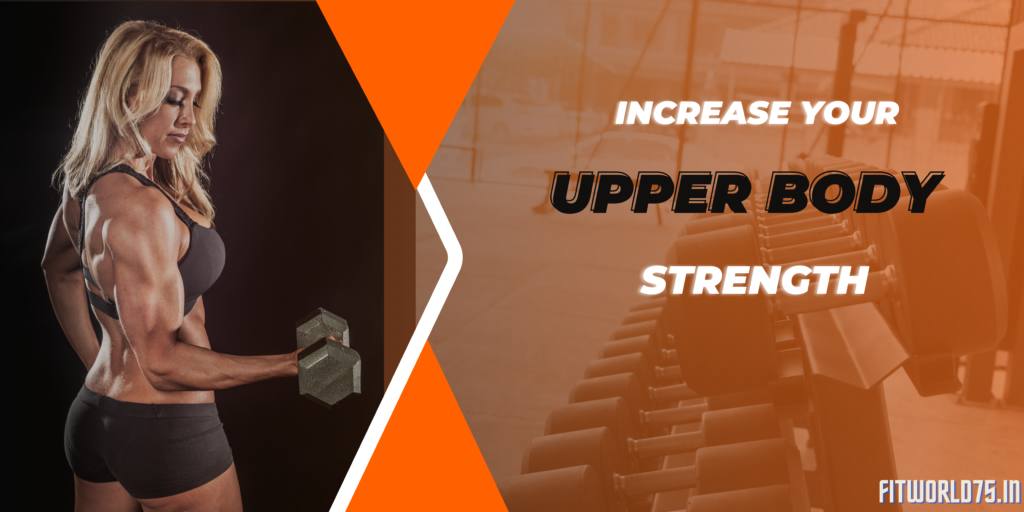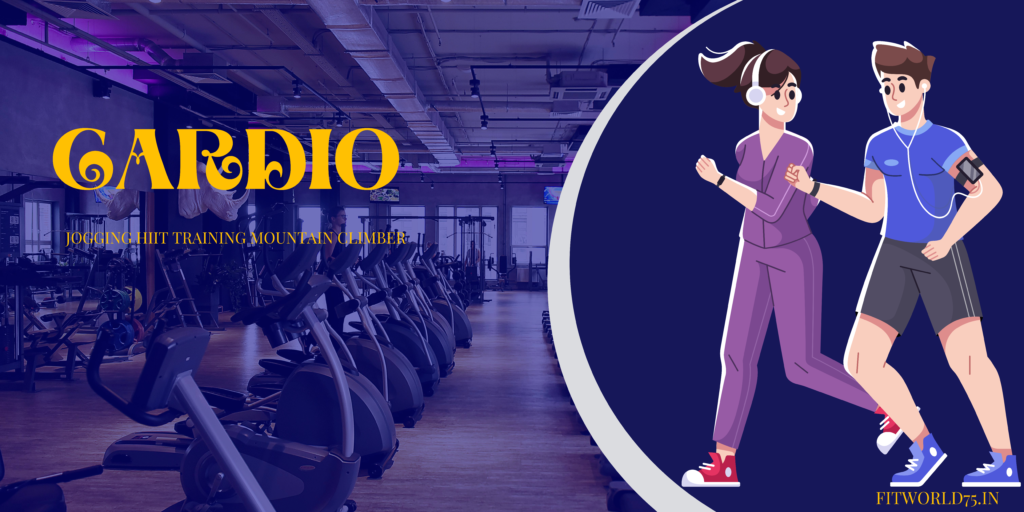Introduction
Putting effort into your upper body is essential if you want to develop a balanced and shaped physique. A complete upper body workout improves muscle tone, functional fitness, and strength development. In this in-depth guide, we will go into the area of full upper body workouts, analyzing the advantages, exercises, and tactics to support your fitness goals.
Benefits of a Full Upper Body Workout
Let’s take a moment to figure out why an upper body workout is an essential part of any fitness program before we get into the details of a thorough upper body workout.
Increased Muscle Definition
The growth of muscles with a defined appearance is one of the main advantages of an extensive upper body workout. This exercise program targets all the key upper body muscular groups, allowing you to get the toned appearance you like, whether your goal is to have biceps that pop out, chiseled chest muscles, or sculpted shoulders.
Enhanced Functional Strength
Not only does strengthening your upper body look excellent, but it also makes you more useful. A strong upper body is necessary for sustaining an active and self-sufficient lifestyle since it makes it easier to handle large objects and do mundane tasks.
Table of Contents
Improved Posture
Poor posture is a common result of spending a lot of time sunk into devices or at workstations. Exercises that strengthen the muscles essential for maintaining an upright posture are a part of a full upper body workout, and they will help you stand upright and confident.
Enhanced Metabolism
A full upper body workout that involves numerous muscle groups may drastically increase your metabolic rate. Your body will burn more calories even when at rest if your metabolism is higher, which can help you maintain a healthy weight and reduce fat.
Now that you are aware of the benefits, let’s set out on a quest to develop the ideal full upper body workout routine.
Setting Up Your Workout Space
Making an appropriate workout area is the first step in your quest toward a full upper body workout. Here are some things to think about whether you’re exercising at home or in a gym.
Choosing the Right Equipment
You’ll need a range of tools, such as dumbbells, barbells, resistance bands, and a pull-up bar, to effectively concentrate on all upper body muscles. Choose weights and resistance levels that will make you work harder without causing you to lose your form.
Creating a Comfortable Workout Environment
A clutter-free, well-ventilated workout area is necessary for an effective session. To keep you motivated and concentrated during your workout, make sure the environment is well-lit and free from any distractions.
Warm-Up Exercises
Warming up your muscles before lifting weights is vital for reducing the risk of injury and increasing flexibility. Include these warm-up activities in your fitness routine.

Importance of Warming Up
By increasing blood flow to your muscles and increasing your core body temperature, a proper warm-up gets your body set for the workout that will follow. This lowers the chance of sprains and strains.
Dynamic Stretches
The most effective stretches for loosening up your upper body are dynamic ones like arm circles, shoulder rolls, and neck tilts. To improve joint mobility, hold each stretch for 10 to 15 seconds.
Rotator Cuff Exercises
The rotator cuff is a key component of shoulder stabilization. To strengthen this area and avoid injuries, include rotator cuff exercises such as external rotations using tension bands.
Let’s get to the core exercises in your full upper body workout program now that you’ve warmed up.
Core Exercises
Upper body strength is built on a solid core. These basic workouts should be a part of your full upper body workout program.
Planks for Stability
Planks work to strengthen your abdominis and obliques, as well as the rest of your core. Hold the plank posture for 30 to 60 seconds while keeping your body in a straight line from your head to your heels.
Russian Twists for Obliques
Your oblique muscles are the primary focus of Russian twists. Sit on the floor with a weight or medicine ball in your hands, lean back slightly, lift your feet off the floor, and twist your torso to touch the ground on both sides.
Leg Raises for Lower Abs
By laying on your back and raising your legs, you can tone your lower abs. Hold your core the entire time while you drop them back down slowly without allowing them to contact the ground.
Chest and Shoulder Exercises

Now let’s emphasize on using these workouts to develop a muscular chest and broad shoulders.
Push-ups for Chest
A traditional chest workout that also works your shoulders and triceps is the push-up. To get the most out of them, perform them appropriately.
Dumbbell Presses for Shoulders
Deltoid muscles are worked out with dumbbell presses, including overhead and lateral versions. For muscle building, use good technique while slowly increasing the weight.
Incline Bench Press Variations
Bench presses on an angle provide you with a special way to target your upper chest. To work different parts of your chest, adjust the bench’s angle.
Back Exercises
In addition to improving posture, having a powerful back also helps your upper body as a whole. These back exercises are beneficial.
Pull-ups for the Lats
To strengthen your latissimus dorsi (lats), try doing pull-ups. Use an assisted pull-up machine or resistance bands for building strength if you’re new to pull-ups.
Bent-over Rows for Upper Back
Your upper back and rhomboid muscles are worked by bent-over rows. Maintain a straight back while executing this exercise while using a barbell or dumbbells.
Face Pulls for Rear Deltoids
Face pulls strengthen your shoulders by concentrating on your back deltoids. Pull the rope towards your face while pulling your shoulder blades together using a rope attachment on a cable machine.
Arm Exercises
Without arm workouts, no upper body workout is complete. These workouts are going to tone and strengthen your forearms, triceps, and biceps.
Bicep Curls for Biceps
To strengthen the different areas of your biceps, perform a variety of bicep curls, such as standing curls, hammer curls, and concentration curls.
Triceps Dips for Triceps
You can perform triceps dips on parallel bars or a bench. Push yourself back up to strengthen your triceps after lowering your torso until your elbows are at a 90-degree angle.
Hammer Curls for Forearms
Hammer curls tone the muscles in your forearms and brachialis. Maintaining a neutral grip, curl dumbbells with your hands facing one another.
Incorporating Cardiovascular Elements
Consider including cardiovascular exercises in your daily routine to improve the quality of your entire upper body workout. Here is why it’s advantageous.
Benefits of Cardio in a Full Upper Body Workout

Jumping jacks, mountain climbers, and even jogging are cardiovascular activities that can raise your heart rate while enhancing your overall endurance. Additionally, they support calorie burning, encourage fat loss, and lessen muscle soreness during exercise.
High-Intensity Interval Training (HIIT)
Short bursts of vigorous activity are combined with quick rest intervals in HIIT. A full upper body workout that includes HIIT will increase your metabolic rate and maximize calorie burn.
Rest and Recovery
For avoiding overtraining and promoting muscular growth after a strenuous activity, adequate rest and recovery are crucial. Think about the following advice.
The Importance of Rest Days
Rest days are important for promoting muscle growth and restoration. To avoid injury and burnout, aim for at least one or two rest days each week.
Proper Nutrition for Recovery
To support muscle rebuilding and recovery, feed your body the correct foods, such as protein, carbs, and healthy fats.
Stretching and Foam Rolling
Stretching and foam rolling should be part of your post-workout routine to increase flexibility and lessen pain.
Common Mistakes to Avoid
Even the most committed people sometimes stumble in their pursuit of fitness. Be mindful of these typical risky situations.
Overtraining
Overtraining, which can result in weariness, low performance, and a higher risk of injury, can be brought on by excessive training without enough rest.
Poor Form and Technique
Exercises done with poor form can injure you and impede your progress. Always lift lighter weights with the right technique before going heavier.
Neglecting Rest
Rest days are necessary. Lack of rest might impede your growth and raise your risk of overuse problems.
Tracking Your Progress
To maintain motivation and reach your fitness goals, it’s critical to keep record of your progress. Here’s a successful method to go about it.
Setting Goals
To monitor your progress and maintain motivation, set exercise goals that are precise, measurable, and achievable.
Keeping a Workout Journal
Keep track of your exercises, sets, reps, and weights utilized in a workout log. You can see where you need to make changes by doing this.
Monitoring Body Composition
To determine whether your full upper body workout was effective, keep track of changes in your body composition, such as your muscle mass and body fat percentage.
Advanced Techniques and Variations
Consider these advanced methods and changes for people wishing to boost their full upper body workout.
Progressive Overload
To consistently put your muscles under stress and encourage muscle growth, gradually increase the weight or resistance in your exercises.
Supersets and Drop Sets
Use drop sets (dropping weight between sets) and supersets (doing two exercises back-to-back) to boost your workouts and promote muscle growth.
Isometric Exercises
Static muscular contractions are part of isometric exercises. To increase strength and endurance, incorporate isometric holds such as planks and wall sits.
Incorporating Full Upper Body Workouts into Your Routine
Let’s talk about how to efficiently implement full upper body upper workouts into your fitness program now that you have an in-depth knowledge of them.
Frequency and Scheduling
According to your overall schedule and fitness objectives, decide how frequently you’ll undertake full upper body workouts. Beginners may begin with two to three weekly sessions, while more experienced people may increase the number of sessions per week.
Combining with Lower Body Workout
Complement your full upper body training with lower body workouts for a well-rounded physique. Develop a balanced weekly workout plan that includes all major muscle groups.
Cross-Training Options
To improve your flexibility and avoid reaching fitness plateaus, think about including cross-training activities like swimming, yoga, or Pilates.
Staying Motivated
The accomplishments of your fitness journey over the long run depend on your ability to stay motivated. Here are some ideas to help you stay motivated.
Finding Workout Buddies
Exercise can be more fun and accountable when done with a friend or a partner.
Celebrating Milestones
Whether you complete a specific weightlifting objective or you finally fit into your favorite pair of pants, you should be proud of yourself.
Exploring New Exercises
To keep your workouts interesting and new, don’t be hesitant to try new exercises and variations.
Conclusion
In conclusion, a full upper body workout is an effective way to increase strength, improve muscle tone, and raise fitness levels in general. You can design a successful program for working out your full upper body that is suited to your goals according to the instructions in this detailed guide. On your quest for a stronger and more toned upper body, keep in mind that appropriate form, rest, and growth are priorities. Set up a routine for your entire upper body today and reap the transforming rewards for yourself.

